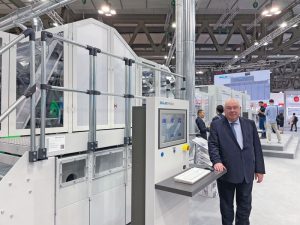
ITMA 2023 exhibitors in the nonwovens arena embraced the show’s sustainable theme.
By Dr. Behnam Pourdeyhimi, Technical Editor
In North America and Europe, spunmelt nonwoven technologies— spunbond and meltblown technologies and their composites — dominate, while in the rest of the world, staple fiber process technologies dominate. Note that the spunmelt technologies are becoming significant in Asia Pacific as well. Europe, North America and Asia Pacific are responsible for more than 75 percent of the world’s nonwovens production.
Today, most lightweight, disposable products are produced using the spunmelt process. No other technology can compete easily in this domain in terms of speed, quality and cost. These machines are multi-beam spunbond/meltblown/spun-bond systems, where six or seven beam machines are common — producing multi-layered composites that weigh between 8 and 50 grams per square meter (gsm), with each beam laying down 1 to 2 gsm. Naturally, this high rate of production is intended for disposable applications such as medical and hygiene products. However, for geosynthetics, where the basis weight is often more than 100 gsm, spunbond and carding technologies are used. Here, the spunbond often is a single or dual beam unit. In heavier products, carding technology dominates; an example would be nonwovens used in the automotive sector.
Recent and continuing advances in the high-speed carding and high-volume carding production technology will allow this technology to continue to dominate these market segments, and the advances in crosslapping technology and higher weight nonwovens through chute-feed systems will encourage the use of such technologies for heavier weight products. It is the author’s opinion that the high-speed carding technology and its associated processes are not maturing technologies that are holding their own. Another key difference between textile machinery makers and nonwovens machinery makers has been the degree of vertical integration in these two segments. Starting in the late 80s and early 90s, alliances and mergers began within the industry. Some of these deals took the form of horizontal integration — buy-out of parallel or competing technologies. Some deals took the form of vertical integration, which encouraged one-stop shopping where the buyer could purchase complete manufacturing lines to produce nonwovens for specific markets. In the latter case, the machines from different parts of the alliance, merger, or partnership were better integrated as well.
Nonwovens At ITMA 2023
ITMA 2023 was another phenomenal success. In the style of previous ITMAs, the event was thoughtfully organized and comprehensive. The nonwovens machinery industry con-tinues to embrace increasing participation in ITMA, although many key players were not present with exhibits including Reicofil, Parkinson and Hills, for example.
These noticeable absences are partly due to the fact that historically, the nonwovens industry has been organized differently and separately from the textile industry. What differentiates the nonwovens and the textile industries is primarily in the product sector. Nonwovens are not used in fashion and apparel. Further-more, to compete in a global economy and offer competitive products — disposable, but not always — requires that the labor component of the total cost be very low. Therefore, high speed, large volume and full automation is required in nonwovens production. This in turn, means that short runs and flexibility in offerings becomes limited. The nonwoven industry has grown to present a broad array of engineered fiber and polymer-based products that are driven by high-speed, low-cost, innovative, value-added, fully automated processes. This has led to a separation from the more traditional textiles which has been primarily focused on apparel and customization.
ITMA Themes, Exhibits
Many visitors came from India, Pakistan, the Middle East and Gulf countries, and North and Latin America. The attendance from Europe and Asia was as expected, with a much higher number of Chinese customers present at the event.
A number of themes were evident at ITMA 2023. Sustainability continues to be a major theme and that dominated some of the sessions, discussions and awards. Almost entirely, the nonwovens exhibitors had a very high degree of focus on sustainability including recycling, lower energy consumption and use of natural fibers such as cellulose. Another theme that was evident was automation, and the adoption of machine leaning for process control and optimization.
Once again, most companies exhibiting at ITMA were primarily those focused on the conversion of staple fibers into nonwovens through carding/crosslapping, pseudo airlay, and associated bonding technologies. Often, those exhibiting companies also have offerings for the textile industry and see an opportunity in specific areas.
The nonwovens machinery industry continues to go through massive changes — reconsolidation together with product differentiation has resulted in many advanced systems — changes that only benefit their customers.
Today’s sectors of the industry include raw material suppliers, roll goods producers, the converters/fabricators of the end use products, machinery industry supporting the previous three categories, auxiliary material suppliers, winding, slitting, and packaging equipment makers, among other sectors. With more consolidation, some of this segmentation is rapidly changing.
In terms of market segments, nonwovens products are used in medical and hygiene, filtration, wipes, automotive, industrial and interlining — the only segment directly related to apparel — applications.
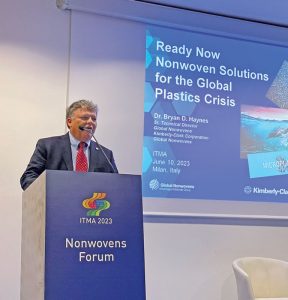
The nonwoven section at ITMA continues to grow, but will likely not grow too rapidly. The customers in attendance at ITMA are often not the same as those customers from the nonwoven machinery sector — although that line is becoming increasingly fuzzy. In 2019, the European Disposables and Nonwovens Association (EDANA) ran a program at ITMA focused on the use of nonwovens as a way to make the broader textile community aware of opportunities in nonwovens sectors. In 2023, ITMA organized the ITMA Nonwoven Forum in collaboration with organizations including NC State’s Nonwovens Institute, The University of Leeds, Deutsche Institute für Textil (DITF), and others, who helped ensure that the topics were relevant and timely. The talks were well received, and the session was a success.
Impressions, Significant Process Technologies
This report is not intended to be an exhaustive review of the process technologies offered for the nonwovens segment. Note also that the following is presented in no particular order, and merely tries to catalog the recent innovations reported at the show and focuses on companies that have established themselves as leaders in the nonwovens machinery industry.
Germany-based Dilo Group had a very prominent booth at ITMA 2023. Dilo has been a major innovator in the area of process technologies for staple nonwoven products. Dilo also has offered complete systems for some time and continues to be a major innovator in the field of machinery for forming staple fibers products from hygiene to industrial. It was the first to introduce the HyperPunch followed by the CycloPunch and now the MicroPunch technology. Its velour and pile needle looms also represent major developments in this arena.
Dilo introduced this completely new concept for intensive needling, referred to as MicroPunch, in part to allow the formation of entangled, lighter weight webs intended for use in products such as wipes.
The MicroPunch technology is potentially a gamechanger. Needling historically has been used in the production of heavier felts. The Micro-Punch changes this tradition and webs as light as 30 to 100 gsm can be produced using needling.
The concept was developed to provide an alternative to hydroentanglement, which is an energy intensive process but is incredibly effective for lighter weight webs. Coupled with Dilo’s Spinnbau carding technology, intensive needling is a completely new paradigm. The technology uses small needles — approximately 20 to 40 microns in size — with perhaps a single barb, where many more needles are required to effectively needle the web. This design required a completely new approach to how needles are constructed and how they can populate the needle board.
Another industry giant, Germany-based Groz-Beckert KG, took on the needle challenge and created a completely new way of making the needles while making it easy to populate the board by creating needle modules. The MicroPunch technology features up to 45,000 needles per meter (m) per board and can achieve stitch densities of 800 to 900 stitches per square centimeter at a line speed of 140 meter per minute (m/min). The previous record in terms of the number of needles/m/board was 20,000 — introduced at ITMA 2007 in Munich by Dilo.
In the new Groz-Beckert felting needle module X22, needles are embedded as a module in a plastic mold. The felting needle modules are characterized by very high deformation resistance and offer new dimensions in needle density. The assembly and replacement of the modules are said to be fairly economical. The new needle “container-board” has the same features as a classical needle board and can be exchanged on the needle beam as in the past within a few minutes by a pneumatic clamping system. Cleverly, the needle board patterns are designed to mimic the look of hydroentangled fabrics with lines along the machine direction — jet streaks — or a random pattern that removes the appearance of the lines. Dilo reports that the MicroPunch reduces energy consumption by 75 percent compared to hydroentangling.
The MicroPunch line at ITMA consisted of DiloTemafa fiber preparation, opening using a BALTROMIX bale opener, carding willow and dosing opener of the latest design followed by DiloSpinnbau MultiCard fed by a universal card feeder including the new IsoFeed system for reduced weight variation. IsoFeed can improve the overall CV value by approximately 4 percent. The high degree of uniformity of the web results in a reduction of the average weight by approximately 10 percent leading to savings. The MicroPunch line on display at ITMA was shipped back to Dilo’s research and demonstration center where DiloGroup will use it for product development and customer trials.
Dilo also announced partnerships with Italy-based companies Dell’Orco & Villani S.r.l. and TechnoPlants S.r.l. The collaboration allows the supply of complete turnkey lines for recycling. Dell’Orco & Villani is an innovative company specialized in tearing and shredding equipment, and TechnoPlants’ aerodynamic web forming technology is particularly suitable for reclaimed fiber processing.
Groz-Beckert is a global supplier of needles and precision parts. as well as systems for the production and joining of fabrics. Its products support knitting, weaving, needlepunching (felting), tufting, carding and sewing. The company also manufactures and distributes process-critical textile precision tools, industrial cutting solutions, and reinforcement solutions made from high-performance technical fibers for composite materials.
In the felting/needling area, two new products were showcased at ITMA — the needle module for Dilo’s MicroPunch, and a new notch felting needle specially developed for needling highly abrasive fibers to minimize wear and reduce notch clogging.
Groz-beckert offers jet strips for hydroentangling — HyTec™ —which are known for their significantly improved wear resistance and handling properties. The company also showcased innovations in new gauges of tufting needles for products such as floor coverings and artificial turf. In the carding area, Groz-Beckert is a relative newcomer to the field of clothing wire. Its new SiroLock™ plus is reported to enhance web uniformity.
Austria-based ANDRITZ AG had a significant presence at ITMA showcasing its existing technologies— including carding technology together with a dynamic crosslapper that reaches speeds of more than 200 meters per minute (m/min), as well as the use of wetlay techniques coupled with hydroentangling and other bonding technologies that is an enabler for the next generation of products, notably, wipes. With the acquisition of France-based Laroche, Andritz now offers a full line of machinery for processing staple fibers, and short cut and recycled fibers including turnkey solutions for carding, spunlace, needlepunch, wetlaid/wetlace and airlaid. Andritz also now offers pulp-based airlay technologies with its acquisition of Denmark-based Dan-Web Machinery A/S. Andritz also offers nonwoven and textile finishing solutions, and components such as belts for hydroentangling, and spunbond and meltblown — as a result of its acquisition of Xerium Technologies Inc., Youngsville, N.C. — and now can offer PGI’s Apex drum technology for hydroentangling for staple fiber-based nonwovens. Note that PGI is now a Berry Global Inc. company.
Andritz Nonwoven pools the expertise of all its companies in technology, research and development, manufacturing, service, and automation, to fully benefiting its customers. The technologies offered complement one another in process solutions for a great variety of applications and contribute to opti-mized and efficient use of resources.
ANDRITZ’s focus at ITMA was on sustainability. This is not a new area for ANDITZ because in the past, it has focused on various sustainable solutions including a reduction in energy consumption with its neXecodry— an energy-efficient drying solution for the spunlace industry.
However, its sustainability innovations at ITMA 2023 went beyond simple energy consumption. Andritz showcased new textile recycling solutions, which are particularly targeted at textile companies that have an interest in recycling textile waste streams to help clients achieve sustainability goals and reduce the overall carbon footprint.
Andritz showcased its spunlace, needlepunch, and Laroche airlay lines; and most importantly, its ability to process 100-percent biobased or natural fibers, as well as reclaimed fibers and/or recycled fibers.
One of the highlights was its PA.3000 elliptical cylinder pre-needler, which is said to be ideal for creating very even and uniform fabrics, especially when used with the Andritz ProWin™ web profiler. Another innovation by Andritz is its high-performance Wetlace™ process for flushable, dispersible and biodegradable wipes. The original Andritz Wetlace process combines wetlaid and hydroentanglement technologies, proven for producing flushable wipes from 100-percent natural and/or renewable raw materials without chemical binders. Another feature of its technology is the ability to now apply detailed artwork to flushable wipes using the Apex Drum technology, which offers the ability to create an unlimited range of designs, patterns and apertures. Andritz continues to be the leader in thermal calendaring as well. Andritz also showcased its textile recycling processes. One highlight was the ADuro shredder and fine grinder, used for fine grinding of preshredded textile feedstock down to a very accurate granulate size, while keeping dust to a minimum. These technologies can play an essential role in chemical recycling of textile waste. Another highlight was the Jumbo tearing module, designed for recycling a high volume of textiles, whether post-consumer textile waste or industrial textile waste.
For some time now, Andritz has been focused on digitalization. The company offers a broad range of innovative products and services under the brand name Metris. It combines a complete set of production management, simulation and optimization by using the latest AI technology. A live demo was available at its booth.
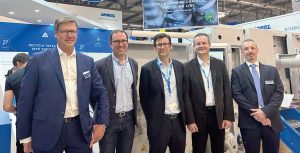
In addition, Andritz announced that it had teamed up with Pellenc ST and Nouvelles Fibres Textiles, both based in France, to set up the very first industrial line in France to combine automated sorting and recycling technology.
The Germany-based Trützschler Group SE has become a dominant player in nonwovens through organic growth, through acquisition — Erko and Fleissner — and more recently, through a partnership with an Italy-based company that offers needlepunching and crosslapping in conjunction with Trützschler carding technology. Trützschler also has been a leader in processing cellulosic fibers, which is becoming more significant in the light of the European Union directives and the concerns around the use of synthetic materials in this age of sustainability. The company’s new developments capable of dealing with recycled materials allow Trützschler to offer complete turnkey systems from “cradle-to-cradle” production, sales and service globally in the staple fiber nonwoven markets.
Trützschler Nonwovens focuses on the variety of manufacturing processes, especially dealing with web bonding, in addition to total integrated turn-key systems. The company now offers a full array of process technologies for staple-fiber nonwovens including, but not limited to, fiber preparation and blending, carding, air card, crosslapping, needlepunching, hydroentangling, thermal bonding (through-air), and coating. The four groups of tech-nologies on display included yarn spinning, nonwovens, man-made fiber extrusion and card clothing.
Trützschler has been a leader in the preparation and processing of cotton and other cellulosic fibers, which was very clearly illustrated at the show. It showcased various new and improved cotton processing technologies including the BO-P bale opener; CL-X two-step cleaning process; and TC 30 card, which features the T-GO gap optimizer for higher quality and productivity.
Trützschler also unveiled the new Modular High-Performance Dryer (MPD). Today, hydroentangled nonwoven producers — especially those using cotton, viscose or pulp fibers as raw materials — are under increasing pressure to keep energy costs low and cut greenhouse gas emissions. Trützschler Nonwovens has responded to this need with the innovative through-air MPD dryer that can be adapted and constructed to meet each plant’s, nonwoven’s and customer’s unique requirements. The modular design features a patented, separate intermediate chamber between the drying and heating chambers. This design allows water-saturated circulation air to be extracted before fresh air is sucked in and heated. The result is significantly reduced the amount of energy needed for the drying process compared to dryers without a separation of circulation and fresh air flows.
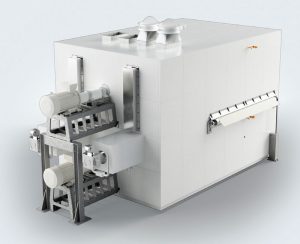
MPD is available as either a stand-alone single drum dryer or a two-module, space-saving vertical dryer. It is designed for both classic heating systems such as natural gas, electric, steam or thermal oil, in addition to environmentally friendly hydrogen and biogas burners. The two-module configuration is even capable of using two different heating systems. Gas burners in the first module are for instance accompanied by electric heating in the second module, allowing for a customer-specific heating solution.
At ITMA 2023 Trützschler also announced its partnership with the Italy-based textile machinery manu-facturer Texnology S.r.l. to offer complete production lines for needlepunched nonwovens under a new brand called T-SUPREMA. A first joint project has already been successfully completed, implemented and is in operation.
Texnology offers a number of sys-ems for the nonwovens industry. The company develops and manufactures needle looms, web drafters, profiling systems and high speed crosslapper systems. The Texnology site in Fontaniva, Italy, offers a show room with a complete needlepunching line for customer materials.
Autefa Solutions, Germany, also had a significant presence at ITMA. It showcased several key technologies including its fiber recycling solutions together with the V12/r aerodynamic web forming technology coupled with various needling solutions. Interestingly, it also offers a wetlaid/hydroentangling line in collaboration with Slovenia-based PAMA Paper Machinery for processing 100-percent cellulosic materials, including pulp, viscose or lyocell fibers. Autefa offers a full range of turnkey machinery including carding, crosslapping, airlay, needling, hydroentangling and thermal bonding. Higher productivity, sustainability and Industry 4.0 compatible solutions were the highlights of AUTEFA presentations at ITMA 2023.
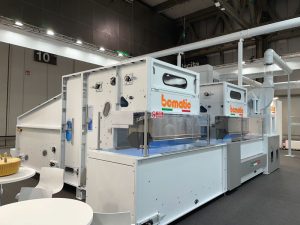
Bematic, Italy, has been developing and manufacturing nonwoven production lines for almost 50 years. The company provides turnkey solutions customized to specific production requirements. Bematic showcased its new carding line and new airlay technology at the show. Bematic has been collaborating with the Germany-based Fraunhofer Institute for Industrial Mathematics (Fraun-hofer ITWM) and Switzerland-based Siriotek GmbH to develop the next generation of airlay machines to ensure performance and quality in processing with staple fibers whilst reducing energy consumption, waste generation and carbon emissions.
CL Nonwoven, a China-based manufacturer of spunbond and meltblown machinery also exhibited at ITMA 2023. It had a wide range of fabrics on display including spunbond, meltblown and SMS structures mostly made from polypropylene (PP) and polyethylene (PE). The quality of the fabrics was surprisingly good. CL Nonwoven has been aggressively marketing its capabilities and is present at many exhibitions globally. CL Nonwoven is a company to watch.
France-based Spoolex S.a.s. offers efficient converting equipment and components including ultrasonic cutting and welding equipment, and industrial rollers. Its Converting Machinery division has offered unwinding, slitting, rewinding equipment since 1955 for a wide range of markets. Spoolex’s range of products includes slitter-rewinders, turret winders, spooling lines, but also, non-stop-winders, splicing benches and slitting benches, from simple equipment to fully automated cells. Their modular design allows the machines to be fully customizable and they may be fitted with different unwinding, slitting and rewinding technologies for materials ranging from thick, lofty materials to thin materials. Spoolex’s Decoup+ ultra-sonic technology performs clean and soft edges; and its Industrial Rollers division has been offering industrial idler rollers, chill rollers and winding cores since 1991.
Oerlikon was at the show but was showcasing its new staple fiber process and did not focus on its non-wovens machinery.
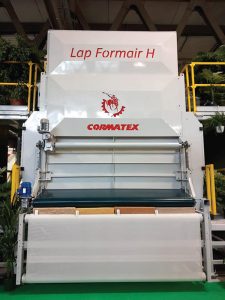
Cormatex S.r.l., a well-known Italy-based company, presented its horizontal airlay machine nicknamed Lap formair H, a high-speed cross-cutting machine, and a water recycling gallery. Cormatex’s airlay technology is capable of processing different types of fibers — virgin or recycled — as well as various waste materials for different applications in furniture, mattress, automotive, thermal and acoustic insulation, and agriculture among other applications. A key feature of this machine lies in its capability for processing fibers as well as non-fibrous materials including very short fibers down to 1 millimeter in length. The webs can range from 100 gsm to more than 5,000 gsm at throughputs approaching 500 kilograms per hour per meter. The machine is capable of processing powder resins as an alternative to low-melt fibers.
Its cross-cutting technology is designed to perform a very precise and straight cut without stopping the line at cutting cycles lower than 2 seconds.
In addition, Cormatex’s gallery of various nonwoven samples show-cased a wide range of materials from recycled leather waste or recycled paper products, to various types of vegetable and wood fibers.
Ramina S.r.l., another innovative Italy-based company, also had a large presence at ITMA. It showcased the Leonardo 1.0 technology in spunbond, meltblown and composite lines. It had samples of materials on hand made using PP, PE, polyamide, polybutylene terephthalate, polyester and polylactic acid. The company also offers carding and needling lines, airlay lines and thermobonding lines. Ramina is relative newcomer, but one that is growing rapidly and expanding its portfolio of products. This is another company to watch.
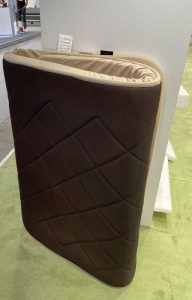
Vertical Lapping
An interesting surprise was the rebirth and growth of vertical lapping technology. Australia-based V-Lap exhibited its new vertical lapping system. The company first exhibited at ITMA 2011 but did not get any traction partly because it was a start-up. It clearly is not a start-up any longer!
Vertical Lapping is not new. Known in the industry as STRUTO, many are familiar with vertical lapping. Struto is a nonwoven structure where all the fibers are orientated in the vertical position. This gives the highest possible resilience and recovery after repeated compression at varying levels of thicknesses. This differentiates it from lapped webs or high loft airlaid products. These nonwovens are superior in resilience and their higher porosity results in better performance in critical applications such as automotive and filtration.
V-Lap offers turnkey systems with complete fiber processing, carding, lapping and bonding up to 3 meters in width. It had a portfolio of products on display including automotive parts — door panels, thermoacoustic materials and seating materials — full sized mattresses, pillows, various forms of air filters, performance clothing, among other products.
Vertical lapping is an interesting technology that will undoubtedly have many niche applications where the unique properties of the structure warrant their use. This is a development worth watching.
Future ITMAs
While the nonwovens sector had a significant showing at ITMA 2023, participation was still less significant than at other nonwoven specific trade shows such as INDEX, IDEA and ANNEX. ITMA is dedicated to textile machinery; consequently, show attendees typically are interested in “textile” products. Most nonwoven users do not consider themselves to be part of the textile community and therefore these customers are not drawn to ITMA. Perhaps this customer division will change in the future as the line between the nonwovens and traditional textile industry continues to blur.
Editor’s Note: Dr. Behnam Pourdeyhimi is the executive director of The Nonwovens Institute (NWI) at NC State University, a consortium of stakeholders spanning the breadth of the nonwovens value chain from raw materials to end-use products. Dr. Pourdeyhimi also serves as the associate dean for Industry Research and Extension at the Wilson College of Textiles at NC State and is a distinguished professor of textile materials and an adjunct professor in Biomedical Engineering, also at NC State. Dr. Pourdeyhimi can be reached at bpourdey@ncsu.edu, +1 919.515.1822.
January/February 2024




